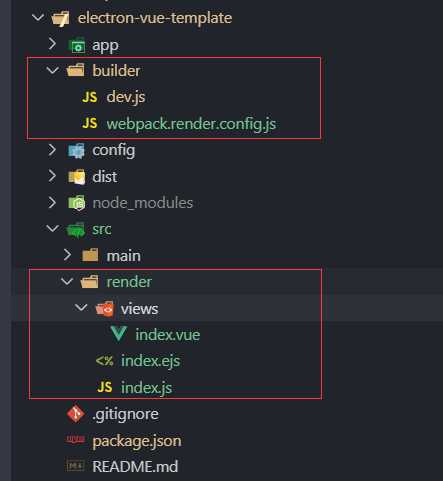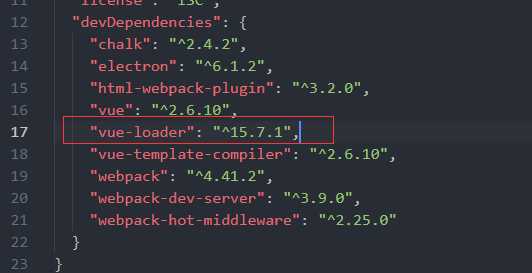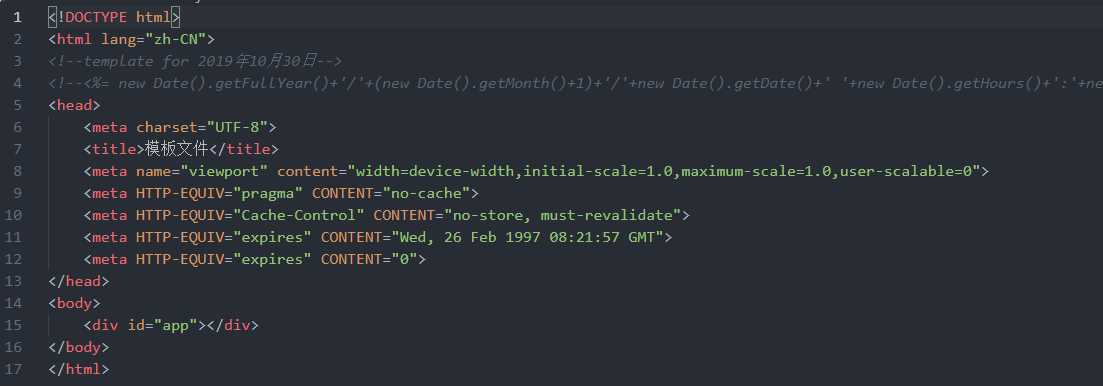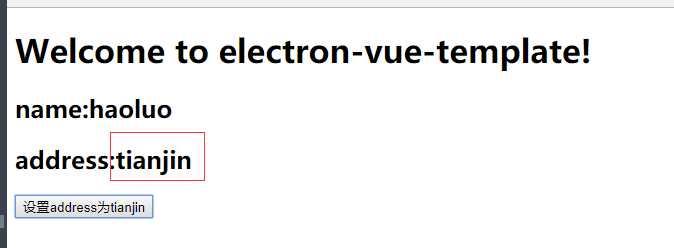标签:日志 set 用户 ogre compile export lse next src
导航:
(一)Electron跑起来
(二)从零搭建Vue全家桶+webpack项目框架
(三)Electron+Vue+Webpack,联合调试整个项目(未完待续)
(四)Electron配置润色(未完待续)
(五)预加载及自动更新(未完待续)
(六)构建、发布整个项目(包括client和web)(未完待续)
摘要:上篇文章说到了如何新建工程,并启动一个最简单的Electron应用。“跑起来”了Electron,那就接着把Vue“跑起来”吧。有一点需要说明的是,webpack是贯穿这个系列始终的,我也是本着学习的态度,去介绍、总结一些常用到的配置及思路,有不恰当的地方,或者待优化的地方,欢迎留言。项目完整代码:https://github.com/luohao8023/electron-vue-template
下面开始~~~

import Vue from ‘vue‘; import index from ‘./views/index.vue‘; //取消 Vue 所有的日志与警告 Vue.config.silent = true; new Vue({ el: ‘#app‘, render: h => h(index) });
2、编写根组件,render>views>index.vue
<template>
<div class="content">
<h1>Welcome to electron-vue-template!</h1>
</div>
</template>
<script>
export default {}
</script>
<style></style>
3、编写html模板文件,render>index.ejs,webpack解析、打包vue文件时,以此模板生成html文件
<!DOCTYPE html> <html lang="zh-CN"> <!--template for 2019年10月30日--> <!--<%= new Date().getFullYear()+‘/‘+(new Date().getMonth()+1)+‘/‘+new Date().getDate()+‘ ‘+new Date().getHours()+‘:‘+new Date().getMinutes() %>--> <head> <meta charset="UTF-8"> <title>模板文件</title> <meta name="viewport" content="width=device-width,initial-scale=1.0,maximum-scale=1.0,user-scalable=0"> <meta HTTP-EQUIV="pragma" CONTENT="no-cache"> <meta HTTP-EQUIV="Cache-Control" CONTENT="no-store, must-revalidate"> <meta HTTP-EQUIV="expires" CONTENT="Wed, 26 Feb 1997 08:21:57 GMT"> <meta HTTP-EQUIV="expires" CONTENT="0"> </head> <body> <div id="app"></div> </body> </html>
4、编写webpack配置文件,builder>webpack.render.config.js,建议按照本文这种方式,把配置文件单独抽出来,这样的话,本地调试和打包可以共用一套配置,只需要传递不同参数就可以了,不要把所有的配置和打包逻辑写在一个文件里,太长、太乱、太难维护
/* Name: 渲染进程配置 Author: haoluo Date: 2019-10-30 */ const path = require(‘path‘); const HtmlWebpackPlugin = require(‘html-webpack-plugin‘); const devMode = process.env.NODE_ENV === ‘development‘; module.exports = { mode: devMode ? ‘development‘ : ‘production‘, entry: { main: ‘./src/render/index.js‘ }, output: { path: path.join(__dirname, ‘../app/‘), publicPath: devMode ? ‘/‘ : ‘‘, filename: ‘./js/[name].[hash:8].js‘ }, module: { rules: [ { test: /\.vue$/, exclude: /node_modules/, loader: ‘vue-loader‘ } ] }, plugins: [ new HtmlWebpackPlugin({ template: ‘./src/render/index.ejs‘, filename: ‘./index.html‘, title: ‘electron-vue-template‘, inject: false, hash: true, mode: devMode }) ] }
适当解释一下:
mode:环境参数,针对不同的环境,webpack内部有一些不同的机制,并对相应环境做相应的优化
entry:入口,webpack执行构建的第一步将从入口文件开始,递归查询并解析所有依赖的模块。配置方式有多种,可参考webpack文档,这里我们配置的路径是‘./src/render/index.js‘,意思是src目录下,render文件夹下的index.js,而webpack配置文件是在builder文件夹下,那这个“./”的相对路径到底是相对于谁呢?这就得说一下webpack中的路径问题了,context 是 webpack 编译时的基础目录,入口起点(entry)会相对于此目录查找,那这个context又是个什么东西?webpack源码有关默认配置中有这么一句话
this.set("context", process.cwd());
这就是context的默认值,工程的根目录,那这个entry的配置就很好理解了。
output:打包的输入配置,路径建议设置为绝对路径。
module和plugins就不多说了。
5、编写本地调试脚本
/** * Tip: 调试渲染进程 * Author: haoluo * Data: 2019-10-30 **/ process.env.NODE_ENV = ‘development‘; const webpack = require(‘webpack‘); const WebpackDevServer = require(‘webpack-dev-server‘); const webpackHotMiddleware = require(‘webpack-hot-middleware‘); const chalk = require(‘chalk‘);
const http = require(‘http‘);
function devRender() { console.log(‘启动渲染进程调试......‘); const webpackDevConfig = require(‘./webpack.render.config.js‘); const compiler = webpack(webpackDevConfig); new WebpackDevServer( compiler, { contentBase: webpackDevConfig.output.path, publicPath: webpackDevConfig.output.publicPath, open: true,//打开默认浏览器 inline: true,//刷新模式 hot: true,//热更新 quiet: true,//除第一次编译外,其余不显示编译信息 progress: true,//显示打包进度 setup(app) { app.use(webpackHotMiddleware(compiler)); app.use(‘*‘, (req, res, next) => { if (String(req.originalUrl).indexOf(‘.html‘) > 0) { getHtml(res); } else { next(); } }); } } ).listen(8099, function(err) { if (err) return console.log(err); console.log(`Listening at http://localhost:8099`); }); compiler.hooks.done.tap(‘doneCallback‘, (stats) => { const compilation = stats.compilation; Object.keys(compilation.assets).forEach(key => console.log(chalk.blue(key))); compilation.warnings.forEach(key => console.log(chalk.yellow(key))); compilation.errors.forEach(key => console.log(chalk.red(`${key}:${stats.compilation.errors[key]}`))); console.log(chalk.green(`${chalk.white(‘渲染进程调试完毕\n‘)}time:${(stats.endTime-stats.startTime)/1000} s`)); }); } function getHtml(res) { http.get(`http://localhost:8099`, (response) => { response.pipe(res); }).on(‘error‘, (err) => { console.log(err); }); } devRender();
都是一些常规操作,可以阅读一下代码。
6、配置启动命令,在package.json中新增dev命令,启动本地调试(先起了再说,报错什么的,见招拆招)
"scripts": { "start": "electron ./src/main/main.js", "dev": "node ./builder/dev.js" },
然后命令行运行npm run dev。。。。。。反正我这儿是报错了。。。说是找不到html-webpack-plugin模块,那就运行npm i html-webpack-plugin -D安装一下,如果步骤一没有做的话,后面可能还会遇到很多模块找不到的情况,解决方法很简单,缺什么安装什么就好了。安装完所有的模块之后,启动,还是报错了。。。。。。
ModuleNotFoundError: Module not found: Error: Can‘t resolve ‘vue‘ in ...
ModuleNotFoundError: Module not found: Error: Can‘t resolve ‘vue-loader‘ in ...
检查了下package.json文件和node_modules,发现我的vue-loader没有装,然后就是装一下(如果没有遇到这个步骤,可以忽略)
再次运行

这个报错就很友好了吗,就是vue-loader告诉你,必须安装vue-template-compiler插件,不然就不工作,那就装一下。
接着运行,就知道没那么容易成功

vue-loader报错说缺少了插件,让检查是否配置了VueLoaderPlugin插件,搜一下这是个什么鬼,看这里,15+版本的vue-loader需要配合VueLoaderPlugin使用,然后看了一下我使用的vue-loader版本15.7.1,那就配一下这个东西。


接着运行,终于没有报错了,但是页面为啥子是白的,我的h1标签呢?冷静下来分析一下问题,页面没有东西说明我打包时生成的html文件有问题(devServer会把打包出来的静态文件保存在内存里),而html文件是根据ejs模板生成的,那会不会是模板配置有问题?

看一下我们的模板,结构是没什么问题啊,但是,没有引用css和js文件啊,也就是我们辛辛苦苦解析vue文件,打包css和js,最后却没有引用。。。好吧,那就再配置一下ejs模板,把相应的文件引入一下
<!DOCTYPE html> <html lang="zh-CN"> <!--template for 2019年10月30日--> <!--<%= new Date().getFullYear()+‘/‘+(new Date().getMonth()+1)+‘/‘+new Date().getDate()+‘ ‘+new Date().getHours()+‘:‘+new Date().getMinutes() %>--> <% function getFilePath(filename,libsPath){ let _filenameSearchIndex=filename.indexOf("?"); let _libsPathSearchIndex=libsPath.indexOf("?"); let _filename=filename.substr(0,_filenameSearchIndex<1?filename.length:_filenameSearchIndex); let _libsPath=libsPath.substr(0,_libsPathSearchIndex<1?libsPath.length:_libsPathSearchIndex); let htmlfilename=path.relative(_filename,_libsPath); return libsPath; } let path = require(‘path‘),jsArr = [],cssArr = []; let filename="./index.html"; //修正目录结构 for(let i=0;i<htmlWebpackPlugin.files.css.length;i++){ let name=getFilePath(filename,String(htmlWebpackPlugin.files.css[i])); cssArr.push(name); } for(let i=0;i<htmlWebpackPlugin.files.js.length;i++){ let name=getFilePath(filename,String(htmlWebpackPlugin.files.js[i])); jsArr.push(name); } %> <head> <meta charset="UTF-8"> <title><%= htmlWebpackPlugin.options.title %></title> <meta name="viewport" content="width=device-width,initial-scale=1.0,maximum-scale=1.0,user-scalable=0"> <meta HTTP-EQUIV="pragma" CONTENT="no-cache"> <meta HTTP-EQUIV="Cache-Control" CONTENT="no-store, must-revalidate"> <meta HTTP-EQUIV="expires" CONTENT="Wed, 26 Feb 1997 08:21:57 GMT"> <meta HTTP-EQUIV="expires" CONTENT="0"> <% cssArr.forEach(css=>{ %><link rel="stylesheet" href="<%= css %>" /> <% }) %> </head> <body> <div id="app"></div> <% jsArr.forEach(js=>{ %><script type="text/javascript" src="<%= js %>"></script> <% }) %> </body> </html>
我们可以在ejs中拿到html-webpack-plugin插件的一些信息,比如插件配置、生成的文件等,然后拿到js和css文件,并引入进来,这里建议看一下ejs模板语法。
我们接着运行,终于出来了。

7、配置打包脚本
在builder文件夹下新建build.js,引入配置,直接运行webpack打包即可,不需要devServer。
/** * Tip: 打包 * Author: haoluo * Data: 2019-10-30 **/ process.env.NODE_ENV = ‘production‘; const chalk = require("chalk"); const del = require("del"); const webpack = require(‘webpack‘); const renderConfig = require(‘./webpack.render.config.js‘); del(["./app/*"]); //删除历史打包数据 viewBuilder().then(data => { console.log("打包输出===>", data) }).catch(err => { console.error("打包出错,输出===>", err); process.exit(1); }); function viewBuilder() { return new Promise((resolve, reject) => { console.log("打包渲染进程......"); const renderCompiler = webpack(renderConfig); renderCompiler.run((err, stats) => { if (err) { console.log("打包渲染进程遇到Error!"); reject(chalk.red(err)); } else { let log = ""; stats.compilation.errors.forEach(key => { log += chalk.red(`${key}:${stats.compilation.errors[key]}`) + "\n"; }) stats.compilation.warnings.forEach(key => { log += chalk.yellow(key) + "\n"; }) Object.keys(stats.compilation.assets).forEach(key => { log += chalk.blue(key) + "\n"; }) log += chalk.green(`time:${(stats.endTime-stats.startTime)/1000} s\n`) + "\n"; resolve(`${log}`); } }) }) }
在package.json中新增打包命令
"scripts": { "start": "electron ./src/main/main.js", "dev": "node ./builder/dev.js", "build": "node ./builder/build.js" },
npm run build执行打包,这次还真是出奇的顺利啊,看一下app文件夹,已经生成了静态文件,然后直接在浏览器打开index.html文件,正常显示。

四、使用vuex,vue-router,axios
说好的全家桶呢,这里我们不用vue-resource了,使用axios。
1、使用vuex
安装vuex依赖,在src>render文件夹下新建store文件夹,并在store文件夹下新增:
actions.js
export default {}
index.js
import Vue from ‘vue‘; import Vuex from ‘vuex‘; import actions from ‘./actions.js‘; import mutations from ‘./mutations.js‘; Vue.use(Vuex); // 这里为全局的,模块内的请在模块内动态注册 const store = new Vuex.Store({ strict: true, state: { userInfo: { name: ‘haoluo‘, address: ‘beijing‘ } }, getters: {}, mutations, actions }); export default store;
mutations.js
export default { //设置用户信息 setUserInfo(state, config) { if (!config) { state.userInfo = {}; } for (var objName in config) { state.userInfo[objName] = config[objName]; } } }
以上三个文件的实力代码,比官网教程还简单,可以自行研究一下文档。
文件建好之后,需要把store挂载到vue实例上,找到vue工程的入口文件,src>render>index.js
import Vue from ‘vue‘; import store from ‘./store/index.js‘; import index from ‘./views/index.vue‘; //取消 Vue 所有的日志与警告 Vue.config.silent = true; new Vue({ el: ‘#app‘, store: store, render: h => h(index) });
然后我们就可以使用啦,找到根组件,src>render>views>index.vue
<template>
<div class="content">
<h1>Welcome to electron-vue-template!</h1>
<h2>name:{{userInfo.name}}</h2>
<h2>address:{{userInfo.address}}</h2>
</div>
</template>
<script>
import {mapState} from ‘vuex‘;
export default {
computed: {
...mapState([‘userInfo‘])
}
}
</script>
<style></style>
mapState是state的辅助函数,是个语法糖,借助mapState我们可以更方面的获取属性,而不需要写一堆啰里吧嗦的东西,通过计算属性computed接收userInfo,然后就可以使用啦,运行本地调试,发现页面上已经可以正常显示了

属性有了之后我们可以使用,但如果想要改变vuex中存储的属性呢?为了保证单向数据流以及方便对数据的追踪等一些其他原因,不建议直接修改vuex的属性,而是需要通过mutations,这里也有一个辅助函数mapMutations,用法同mapState类似,只不过需要用methods去接收,作为一个全局方法使用
<!-- render>views>index.vue -->
<template>
<div class="content">
<h1>Welcome to electron-vue-template!</h1>
<h2>name:{{userInfo.name}}</h2>
<h2>address:{{userInfo.address}}</h2>
<button @click="changeAddress">设置address为tianjin</button>
</div>
</template>
<script>
import {mapState,mapMutations} from ‘vuex‘;
export default {
computed: {
...mapState([‘userInfo‘])
},
methods: {
...mapMutations([‘setUserInfo‘]),
changeAddress() {
this.setUserInfo({
address: ‘tianjin‘
});
}
}
}
</script>
<style></style>
当点击按钮的时候。userInfo中的address被修改了,页面渲染的值也相应的改变了

2、使用vue-router
安装vue-router依赖,在render文件夹下新增router文件夹,并在其中新增index.js
module.exports = [ { path: ‘/index.html‘, name: ‘index‘, meta: { title: ‘首页‘, author: ‘--‘, parentRouter: ‘--‘ }, component: (resolve) => { require.ensure([], () => { return resolve(require(‘../views/index.vue‘)) }, "index") }, children: [] } ];
在入口文件render>index.js中引入并挂载
// render>index.js import Vue from ‘vue‘; import VueRouter from ‘vue-router‘; import store from ‘./store/index.js‘; import routers from ‘./router/index.js‘; import index from ‘./views/index.vue‘; Vue.use(VueRouter); let router = new VueRouter({ routes: routers }) //取消 Vue 所有的日志与警告 Vue.config.silent = true; new Vue({ el: ‘#app‘, router: router, store: store, render: h => h(index) });
运行一下,页面可以正常显示,在地址栏输入http://localhost:8099/index.html时,也是没有问题的,现在新增加一个页面,订单页
<template>
<div class="content">
<h1>order page!</h1>
</div>
</template>
<script>
export default {}
</script>
<style></style>
再配置下路由
module.exports = [ { path: ‘/index.html‘, name: ‘index‘, meta: { title: ‘首页‘, author: ‘--‘, parentRouter: ‘--‘ }, component: (resolve) => { require.ensure([], () => { return resolve(require(‘../views/index.vue‘)) }, "index") }, children: [] }, { path: ‘/order.html‘, name: ‘order‘, meta: { title: ‘订单页‘, author: ‘--‘, parentRouter: ‘--‘ }, component: (resolve) => { require.ensure([], () => { return resolve(require(‘../views/order.vue‘)) }, "order") }, children: [] } ];
并在首页index.vue中增加跳转按钮,运行之后,发现跳不过去,尴尬~~~,路由跳转,需要有<router-view></router-view>去接收才行啊
改造一下吧,views下新增home.vue,把index.vue中的内容拷贝过去,index.vue改为下面这样
<!-- render>views>index.vue -->
<template>
<div>
<router-view></router-view>
</div>
</template>
<script>
export default {
methods: {},
mounted() {
this.$router.push({
name: ‘home‘
});
}
}
</script>
<style></style>
router文件改为下面这样
module.exports = [ { path: ‘/index.html‘, name: ‘index‘, meta: { title: ‘首页‘, author: ‘--‘, parentRouter: ‘--‘ }, component: (resolve) => { require.ensure([], () => { return resolve(require(‘../views/index.vue‘)) }, "index") }, children: [ { path: ‘/home.html‘, name: ‘home‘, meta: { title: ‘home页‘, author: ‘--‘, parentRouter: ‘--‘ }, component: (resolve) => { require.ensure([], () => { return resolve(require(‘../views/home.vue‘)) }, "home") }, children: [] }, { path: ‘/order.html‘, name: ‘order‘, meta: { title: ‘订单页‘, author: ‘--‘, parentRouter: ‘--‘ }, component: (resolve) => { require.ensure([], () => { return resolve(require(‘../views/order.vue‘)) }, "order") }, children: [] } ] } ];
再次运行,页面已经可以正常跳转了。
3、axios,这里暂时不说,后续electron和vue联调的时候会补上。
几点说明:
1、截止目前,webpack配置以及dev和build脚本仅仅是调通大致的流程,还有很多可优化可考究的地方,后续完善项目的过程中会对打包流程逐渐润色;
2、vue全家桶在实际项目中高级用法很多,细节也很多,这里只是最简单的用法,如若用到实际项目中,还要基于目前情况再做细化;
3、本系列文章旨在记录、回顾整个项目框架搭建流程,把握整体结构,很多地方需要根据实际项目再做处理;
4、如有错误或不当的地方,欢迎指出,共同进步!
【原创】从零开始搭建Electron+Vue+Webpack项目框架,一套代码,同时构建客户端、web端(二)
标签:日志 set 用户 ogre compile export lse next src
原文地址:https://www.cnblogs.com/kakayang/p/11766273.html